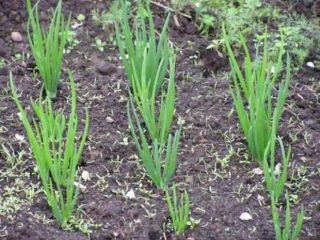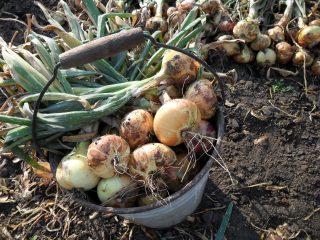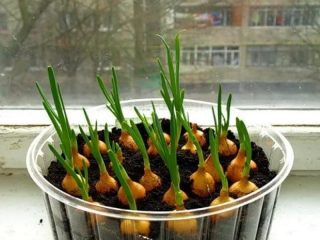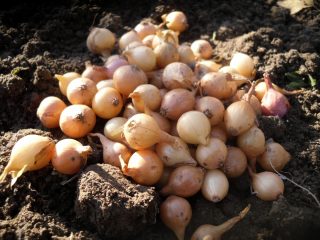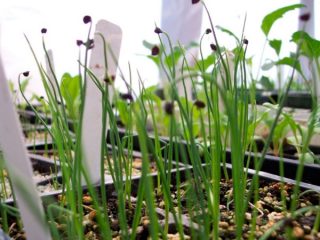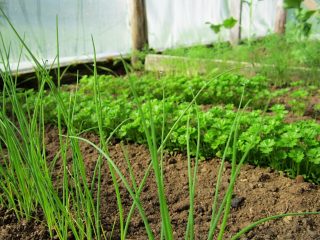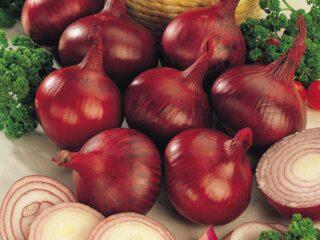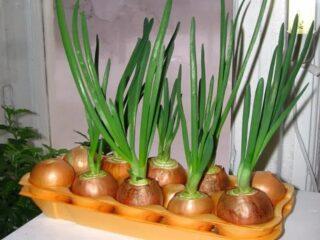Content
- 1 Origin of white onion
- 2 The difference between white onions and regular onions
- 3 Composition and calorie content of white onions
- 4 What vitamins are contained in white onions?
- 5 The benefits of white onions for the human body
- 6 Where are white onions used?
- 7 Features of growing white onions
- 8 Rules of care
- 9 Harvest and storage
- 10 Conclusion
White onion is a perennial garden crop with valuable nutritional qualities. The plant is used in cooking and folk medicine, used to care for the skin of the face, and caring for plantings is not associated with any particular difficulties.
Origin of white onion
White onion is a species variety of the genus of the same name in the Onion family. The plant was first cultivated more than four thousand years ago in Asia, as well as in Greece, India and Egypt. In the Middle Ages, due to its availability, white onions were included in the diet of common people in Europe. Around the 12th century, the culture appeared in Russia and quickly gained popularity.
Currently, white onions are practically never found in wild forms, but grow only in summer cottages and agricultural lands. It has an even round shape and a flat bottom, and is easy to clean from husks.
The difference between white onions and regular onions
White and regular yellow onions are similar in many ways, but there are some important differences. In particular, the first one is distinguished by its larger size, and the husk has a characteristic silvery tint. The structure of white onions is softer than regular onions. Its aroma is more pronounced, and its taste is sweet and delicate, without bitterness.
The difference between onions and white onions is also in the chemical composition. The latter contains an increased amount of sugars, iron and essential oils.
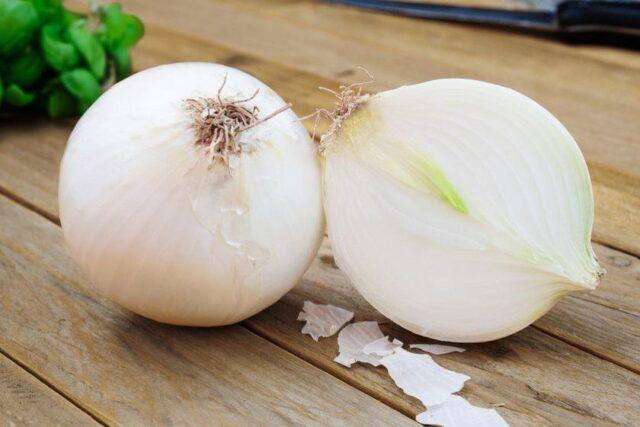
White onions have a shorter shelf life than yellow onions, so they are most often used in salads
Composition and calorie content of white onions
The benefits of white onions are due to their composition. The pulp contains:
- cellulose;
- manganese and iron;
- essential oils;
- antioxidants;
- zinc and phosphorus;
- potassium and magnesium;
- calcium.
The nutritional value of the bulbs is low - 100 g contains about 42 calories. At the same time, about 9.3 g are carbohydrates, and the proportion of fats and proteins is 0.1 g and 1.1 g, respectively.
What vitamins are contained in white onions?
The presence of vitamins also adds value to the product. The pulp contains:
- B vitamins - B1, B2, B5, B6, B9;
- ascorbic acid;
- vitamin H;
- tocopherol;
- nicotinic acid, or vitamin PP.
Regular consumption of bulbs prevents the development of vitamin deficiency and strengthens the immune system during the cold season.
The benefits of white onions for the human body
White onions in a regular diet have a beneficial effect on the body. In particular, the product:
- serves as a good prevention of ARVI and influenza and helps in treatment;
- promotes healing of wounds, burns, abscesses and calluses;
- protects the cardiovascular system from diseases;
- cleanses the blood;
- normalizes the water-salt balance of the body;
- stimulates intestinal motility;
- balances hormonal levels in women;
- promotes collagen synthesis and improves skin condition;
- strengthens hair follicles and helps fight dandruff;
- stimulates weight loss when consumed on a diet;
- supports liver and kidney function;
- restores reproductive functions in men;
- removes waste and toxic substances from the body.
You can take the product for inflammatory diseases of the genitourinary system.
The health benefits and harms of white onions are closely related. It is not recommended to use the product during exacerbations of chronic gastrointestinal diseases - ulcers, gastritis and pancreatitis. In addition, in excess quantities the vegetable provokes an increase in blood pressure.
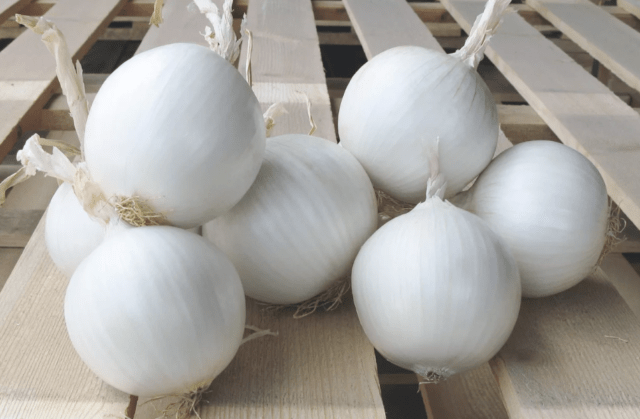
Onion juice relieves itching and burning after insect bites
Where are white onions used?
The medicinal properties of white onions make them valuable not only in the kitchen, but also in other areas. The pulp is used to treat diseases and is used in skin and hair care.
Use in folk medicine
White onions have good anti-inflammatory, analgesic and healing properties. In folk medicine it is used:
- for otitis media and colds;
- for rheumatism and gout;
- for abscesses and ulcers;
- for intestinal parasites;
- for inflammatory diseases;
- for lichen and allergic dermatitis.
White onions can be used both externally and internally.There are several options for using the product.
For swelling
White onions have diuretic properties and help remove excess fluid from tissues. For edema, it is recommended to use the following syrup:
- Finely chop two medium-sized onions.
- Sprinkle the pulp with a small spoon of granulated sugar.
- The raw materials are put in the refrigerator for a day.
- After the period has passed, squeeze out the juice through folded gauze.
It is necessary to take the product three times a day on an empty stomach, 30 ml. In total, treatment is continued for about five days.
For a cold
The properties of white onions help relieve inflammation and fever during colds. For medicinal purposes the following mixture is made:
- Grind one onion and combine with 30 g of honey.
- Place in the refrigerator for four hours.
- Squeeze out the released syrup.
The sweet remedy should be consumed three times a day, 15 ml in between meals.
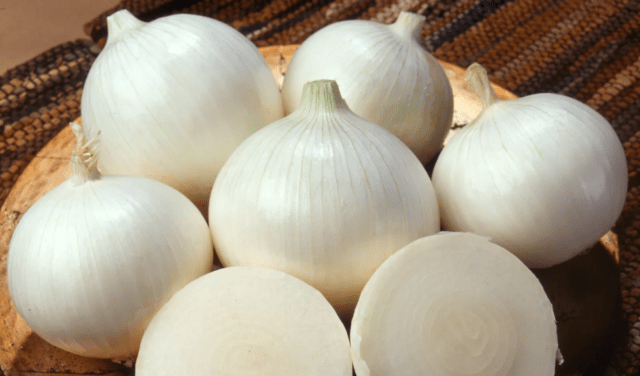
White onions and honey help clear coughs
For prostate adenoma
The medicinal qualities of white onions help relieve unpleasant symptoms of adenoma and slow down the development of a benign tumor. Traditional medicine recommends the following tincture for use:
- The vegetable is crushed in a volume of about 200 g.
- Pour the raw material with 500 ml of dry white wine.
- Place in a cool, dark place for two weeks.
- After the expiration date, filter.
The tincture is taken 30 ml three times a day on a full stomach. The course of treatment takes three weeks, after which they take a break for ten days.
For worms
White onions are beneficial for the human body against worms. It helps remove parasites from the intestines when used together with pharmaceutical products. This infusion gives a good effect:
- A small onion is peeled and grated on a fine grater.
- Pour 200 ml of cold water over the pulp.
- Leave at room temperature, covered, for 12 hours.
The strained infusion is consumed for five days, 100 ml on an empty stomach.
Application in cosmetology
Vitamin white onion has a beneficial effect on skin and hair. It is recommended to use the product for dandruff and hair loss, for pimples and acne, to normalize the functioning of the sebaceous glands.
Anti-dandruff mask
For oily dandruff and easily dirty hair, it is useful to use an onion-cognac mask. Make the remedy as follows:
- Pure juice without pulp is squeezed out of several onions.
- Mix 50 ml of the product with 10 ml of cognac.
- Apply the composition to the scalp at the roots of the hair and leave for an hour, and then rinse off.
You need to use the mask twice a week for a month. After just a few procedures, your hair will acquire a healthy shine, and dandruff will begin to disappear.
Mask for aging skin
For sagging epidermis and the first wrinkles, the following mask has a good effect on the skin:
- White onion is chopped in a volume of 15 g.
- Combine the gruel with an equal amount of honey and milk.
- Bring the components until smooth.
- Apply to face for 20 minutes.
The mask has a tightening and moisturizing effect, improves metabolic processes in skin cells and softens the epidermis.

Onion face masks cleanse pores well and prevent inflammation
White onions in cooking
The low amount of calories in white onions and their pleasant taste make them very popular in cooking. In the kitchen the product is used:
- for preparing salads and snacks;
- when boiling broths and soups;
- in stews and side dishes;
- in marinades and sauces;
- in stuffed dishes.
Onions go well with other vegetables, meat and fish, accelerate the absorption of nutrients from food, and improve the taste of cold and hot dishes. It is used to decorate snacks. Due to their mild taste, white onions rarely cause heartburn or bad breath if consumed in limited quantities.
Features of growing white onions
It is not difficult to grow white onions in the garden - they are quite unpretentious. You just need to choose the right place for the culture and provide basic care.
When to plant white onions
Most often, planting white onions in the garden is carried out in the spring, in the middle or end of April in the middle zone and at the end of March in the south. It is necessary to wait until the snow cover has completely melted and the soil has warmed up; at the same time, the soil must remain moist after the snowdrifts have melted.
Early and frost-resistant varieties can be planted in the autumn - usually from late October to late November. If successful establishment in the ground next year, the crop will sprout early and delight you with green feathers soon after the snow melts on the site.
Seed preparation
Before planting white onions, their seeds need to be prepared. The procedure boils down to soaking and disinfecting the material. The diagram looks like this:
- The seeds are immersed in a light pink solution of potassium permanganate for six hours.
- After time, soak in any growth stimulator for 2-3 hours according to the instructions.
- Transfer to a damp cloth and lightly germinate.
The resulting sprouts must be dried from excess moisture and immediately sown in the ground.
Planting scheme
It is recommended to sow onions in an open, well-lit area with constant access to fresh air. The soil for the crop requires loose and fertile soil with a neutral acidity level. Before planting white onions, you need to dig up the bed properly, add sand and wood ash, as well as complex minerals.
The seeding algorithm looks like this:
- In the prepared area, dig grooves up to 3 cm deep.
- Leave a distance of 25 cm between the rows.
- Seeds are sown in holes and covered with soil on top.
- The soil is compacted and watered abundantly, trying not to wash out the beds.
When planting onions, leave 1-2 cm of space between the seeds to get dense shoots and more green feathers.
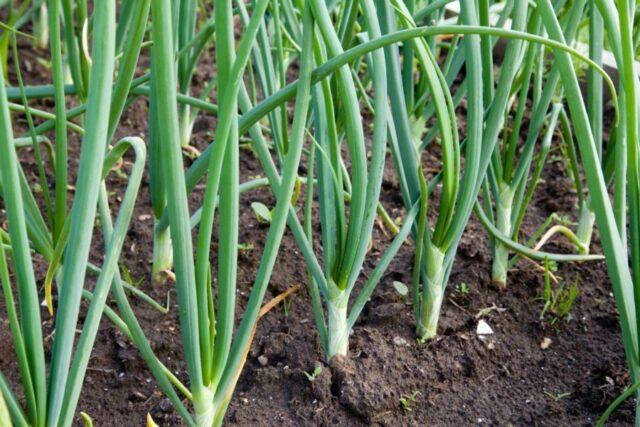
Loamy and sandy loam soils are best suited for white onions.
Rules of care
When growing white onions, you need to pay attention to several points:
- Watering. During periods of drought, the plant requires daily moisture; in rainy weather, the intensity can be reduced. As the bulbs ripen, they water less and less, and 3-4 weeks before harvest, they completely stop adding water.
- Feeding. White onions are fertilized at the beginning of the growing season with liquid manure, mullein or bird droppings. Mineral fertilizers are usually added to the soil during planting; potassium, phosphorus and nitrogen are used.
- Loosening. From time to time, in the onion bed, it is recommended to break up the earthen crust that forms due to watering. Shallow loosening increases soil permeability and improves oxygen access to the roots.
It is recommended that white onion beds be weeded regularly during the growing season. Weeds take away nutrients from the crop and also increase the risk of infection by fungi and pests.
Harvest and storage
The ripening time of white onion varieties may vary - there are early, mid-ripening and late varieties. The right moment for harvesting is determined by the condition of the aboveground part - the feathers should dry out and lie on the ground. After this, on a warm and sunny day, the onion can be carefully lifted from the garden using a fork, undermining the roots. Then it is advisable to leave the plant in the ground for several days until final ripening.
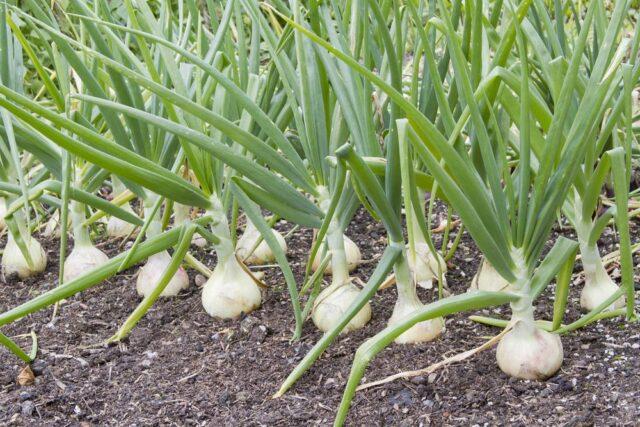
The climate affects the ripening time - onions ripen more slowly in cold and rainy summers
After harvesting, the white onions are cleaned of soil and excess husks and sorted, weeding out damaged heads. The remaining harvest is laid out to dry in a place protected from moisture in the garden, on the veranda or in the attic for 7-10 days. After time, the turnips are placed in wooden boxes or cardboard boxes for storage.
White onions remain usable for the longest time at a temperature of 1 to 3 ° C in a place protected from light. However, it will still not last until spring - it is recommended to consume the crop as quickly as possible.
Conclusion
White onions are an easy to grow and healthy garden plant with valuable nutritional properties. It is added to hot and cold dishes, medicinal tinctures and syrups are prepared from the crushed pulp. Onions have a delicate taste and rich aroma.
